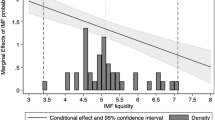Abstract
Monetary policy was too tight in many countries following the financial crisis, due to the lower bound on interest rates. This is likely to have prolonged the recession that followed. This point is illustrated with an assessment of monetary accommodation in the US since the financial crisis, and the accommodation achieved through negative interest rates in countries that have adopted these. The lower bound will likely give rise to considerable economic costs in the future, as it has in the recent past. There is an urgent need to consider how policy tools and frameworks should be adapted.
Similar content being viewed by others
Notes
In the Wicksellian sense.
See Ubide (2017) for a similar point.
A different approach to addressing the question is to estimate how much short-term policy rates normally have been cut to achieve a certain reduction in long-term yields, and apply this estimate to QE-associated reductions in long yields. Such estimates suggest that the monetary stimulatory effect of QE through long yields was equivalent to a stimulus of cut in the policy rate of about 2.5 percent-points in late 2013, which is very close to the loosening implied by the Wu-Xia shadow rate. See Ball et al. (2016), pp. 35–36.
Using the alternative shadow rate estimates for the Federal Funds rate by Leo Krippner would suggest a similar tightening in the years after the crisis, but an earlier achievement of monetary accommodation from 2012 already, see http://www.rbnz.govt.nz/research-and-publications/research-programme/additional-research/measures-of-the-stance-of-united-states-monetary-policy.
Data not shown, but can be obtained from the author. See also Ubide (2017).
References
Agarwal, Ruchir and Miles Kimball. 2015. Breaking Through the Zero Lower Bound. IMF Working Papers 15/224. International Monetary Fund.
Ball, Laurence et al. 2016. What else can central banks do? Geneva Report of the World Economy 18. CEPR and ICMB.
Bean, Charles. 2016. Living with Low for Long. Economic Journal 126(592):507–522.
Blanchard, Olivier J, Giovanni Dell’Ariccia, and Paolo Mauro. 2010. Rethinking Macroeconomic Policy. IMF Staff Position Notes 2010/03. International Monetary Fund.
Blanchard, Olivier J. and Daniel Leigh. 2013. Growth Forecast Errors and Fiscal Multipliers. American Economic Review 103(3):117–120.
BOJ. 2016. Comprehensive Assessment: Developments in Economic Activity and Prices as well as Policy Effects since the Introduction of Quantitative and Qualitative Monetary Easing (QQE). Bank of Japan.
Buiter, Willem H. 2009. Negative Nominal Interest Rates: Three ways to overcome the zero lower bound. NBER Working Papers 15118. National Bureau of Economic Research.
Goodfriend, Marvin. 2016. The Case for Unemcumbering Interest Rate Policy at the Zero Bound, in Designing Resilient Monetary Policy Frameworks for the Future. Federal Reserve Bank of Kansas City.
Grisse, Christian, Signe Krogstrup, and Silvio Schumacher. 2016. Lower Bound Beliefs and Long-Term Interest Rates. Paper presented at the Annual IJCB Research Conference. Federal Reserve Bank of San Francisco.
Holston, Kathryn, Thomas Laubach, and John C. Williams. 2016. Measuring the natural rate of interest: International trends and determinants. Working Paper Series 2016-11. Federal Reserve Bank of San Francisco.
IMF. 2016a. Global Disinflation in an Era of Constrained Monetary Policy. Chapter 3. World Economic Outlook.
IMF. 2016b. Staff Report for Japan. Article IV Consultations. International Monetary Fund.
Koo, Richard. 2014. The Escape from Balance Sheet Recession and the QE Trap: A Hazardous Road for the World Economy. Hoboken: Wiley.
Lo, Stephanie and Kenneth Rogoff. 2015. Secular Stagnation, Debt Overhang and Other Rationales for Sluggish Growth, Six years On. BIS Working Papers 482. Bank for International Settlements.
Rachel, Lukasz and Thomas Smith. 2015. Secular Drivers of the Global Real Interest Rate. Discussion Papers 1605. Centre for Macroeconomics (CFM).
Rogoff, Kenneth. 2016. The Curse of Cash. Princeton: Princeton University Press.
Summers, Lawrence H. 2014. U.S. Economic Prospects: Secular Stagnation, Hysteresis, and the Zero Lower Bound. Business Economics 49(2):65–73.
Taylor, John B. 1999. A Historical Analysis of Monetary Policy Rules. In Monetary Policy Rules. Chicago: University of Chicago.
Ubide, Angel. (2017, forthcoming). The Paradox of Risk: Leaving the Monetary Policy Comfort Zone. Policy Analyses in International Economics. New York: Columbia University Press.
Williams, John C. 2016. Monetary Policy in a Low R-star World. FRBSF Economic Letter 23.
Wu, Jing Cynthia and Fan Dora Xia. 2016. Measuring the Macroeconomic Impact of Monetary Policy at the Zero Lower Bound. Journal of Money, Credit and Banking 48(2–3):253–291.
Author information
Authors and Affiliations
Corresponding author
Additional information
The views expressed in this paper are those of the author and do not necessarily represent the views of the IMF, its Executive Board, or IMF management. Contact: skrogstrup@imf.org. This note is based on panel remarks made at the AEA annual meetings in Chicago, January 2017 NABE sponsored session Responders of First or Last Resort: Central Bank Strategies in an Era of Ultra-Low Interest Rates. I would like to thank Giovanni Dell’Ariccia, Jesper Linde, Machiko Narita, Ted Truman and Niklas Westelius for valuable comments.
Rights and permissions
About this article
Cite this article
Krogstrup, S. Monetary Policy Accommodation at the Lower Bound. Bus Econ 52, 7–14 (2017). https://doi.org/10.1057/s11369-017-0031-7
Received:
Accepted:
Published:
Issue Date:
DOI: https://doi.org/10.1057/s11369-017-0031-7







